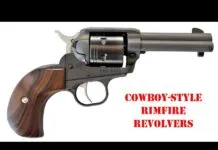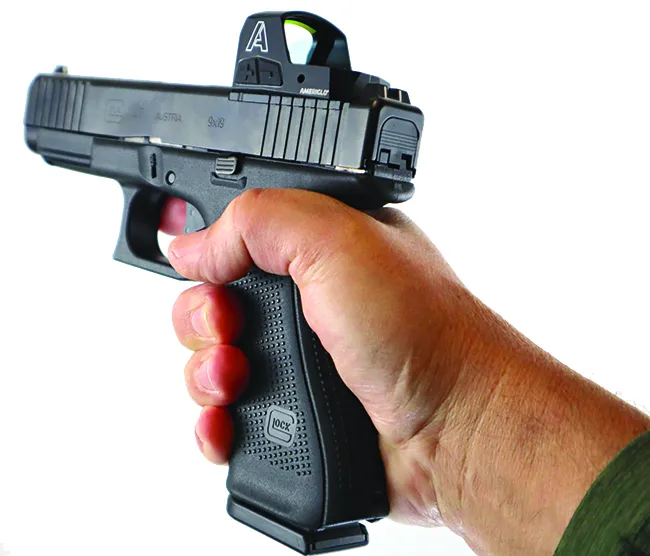Nearly every new 9mm pistol has the slide cut for an optic. While an optic-ready slide is the natural progression for new striker-fire pistols, older platforms are also being adapted to accept a red dot. Take, for instance, the Beretta Model 92 series, a classic double-stack 9mm, which is now available in an optic-ready variant, or the 1911 platform, which is now more frequently being adapted to carry a red dot. Some manufacturers have morphed the platform to accept double-stack magazines, literally doubling the round count in 9mm guns, and called them 2011s. An excellent representation of the diversity in double-stack 9mm pistols that are optic-ready is seen in the Beretta 92X Performance Carry Optic, Springfield Armory Prodigy 4.25, Walther PDP Full Size 4.5, and Glock’s G47 MOS.
We would take any one of these guns in a New York minute, but it would be a tough decision if we had to choose just one. On one hand, there is the simplicity of a striker-fire pistol like the Walther or the Glock, or the crisp 1911-style trigger of the Springfield, or the versatility of the Beretta’s double-action/single-action trigger. Perhaps a heavier gun to help stifle recoil, or a lighter gun for more comfortable concealed carry is the better option? Those were some of the questions we asked when evaluating these excellent pistols, as well as the usual parameters of performance, reliability, accuracy, and ease of use.
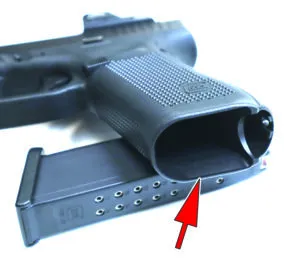
Because these are all optic-ready pistols, we tested four different red dot reflex sights on them. The optics were judged on clarity of the red dot, size of the red dot, brightness adjustment, ease of battery maintenance, ability to co-witness with iron sights, ease of use, and ruggedness. Yes, we dropped expensive pistols with expensive red dots in the dirt so you don’t have to. We also used the red-dot sight as impromptu cocking levers with our hands, on the edge of a shooting bench, and the mouth of a Kydex holster. Front slide serrations are important when a red dot is mounted on these pistols because the optic gets in the way of a traditional pinch-style slide rack where your support hand palms the top of the slide and you pinch the slide between your thumb and index finger to pull back the slide.
The four red-dot sights were an Ameriglo Haven Carry Ready Combo, $329; a Crimson Trace CTS-1250, $230; Steiner’s MPS, $499; and Trijicon’s RMR Type 2, $479. We ranked each pistol on its own merits separate from the red dots. Accordingly, the heights and weights for the handguns don’t reflect the presence of the red dots. But we did pair each gun with a single dot sight for extensive action and accuracy shooting. The red dots offered enough extra precision off the bench that we reported only the accuracy data with each sight aboard. The red-dot grades are listed in the same modules as the pistols they were primarily used on.
How We Tested
We tested the guns/red dots for speed on plain cardboard IPSC/USPSA targets (78 cents each from shop.actiontarget.com) performing the Failure Drill or Mozambique Drill, depending on how politically correct you are. Red dots make aiming much easier than aligning traditional sights, but finding the red dot can be liability, especially in bright light conditions. All the more reason to install co-witnessed iron sights. For accuracy testing at 25 yards, we used Thompson Targets TAC (Training with Audible Cue) targets ($8 per five-pack from ThompsonTarget.com). These targets can be used with a partner who cues the shooter on what part of the target to fire at. The idea with TAC targets is to train the shooter to process commands and make decisions quickly. Scores can be calculated so you can chart your progress and train smart or have bragging rights for the day.

We used both training ammo and defense ammo, with different bullet weights and types. Training rounds consisted of Winchester Active Duty and Federal American Eagle, both loaded with 115-grain FMJ bullets. Defense loads included Remington HTP with 147-grain JHP bullets and SIG V-Crown with 124-grain JHPs. After tabulating the range data, we discovered the Walther had the highest muzzle velocities and the Beretta the lowest, with an average difference of 58 fps. The Springfield and Glock had muzzle velocities in between the two. We also found more differences. For one thing, the triggers on all four were very different, but one gun stood out as our favorite. Here’s what we thought about each gun in more detail.
Glock G47 MOS 9mm Luger, $680
Gun Tests grade: A-
Ameriglo Haven Carry Ready
Combo HVN03, $329
Gun Tests grade: A-
The G47 was originally developed for the United States Customs and Border Protection (CBP) in 2019, and in 2023, Glock made the G47 MOS available to the commercial market. It is the same size as the Glock G17 with a 4.5-inch barrel and full-size polymer frame. Before you yawn, and say big deal, the G47 offers parts compatibility with the G19 Gen5 and G45 Gen5, which is a nice-to-have feature, in our opinion. The G47 comes in a hard case with two backstraps, three magazines, a magazine loader, and it is an MOS variant, so it also comes with an optics plate. The dust cover is shorter than the G17’s, which is one of the features that allows the G47 to be compatible with the other two Gen5 pistols.
| Action Type | Semi-auto, short-recoil-operated |
| Trigger Type | Striker fire |
| Overall Length | 7.9 in. |
| Overall Height | 5.4 in. |
| Maximum Width | 1.3 in. |
| Weight Unloaded | 25.9 oz. |
| Weight Loaded | 33.2 oz. |
| Barrel Length/Twist | 4.4 in.; 1:10 |
| Capacity | 17+1 |
| Slide | Black, steel |
| Slide Retraction Effort | 14.0 lbs. |
| Frame | Polymer |
| Frame Front Strap Height | 2.6 in. |
| Frame Back Strap Height | 3.6 in. |
| Grip | Textured, 3 modular back straps |
| Grip Thickness Maximum | 1.1 in. |
| Grip Circumference Maximum* | 5.5 in. |
| Front Sight | Fixed white dot |
| Rear Sight | U-shape white outline |
| Trigger Pull Weight | 7.6 lbs. |
| Trigger Span* | 2.7 in. |
| Magazines | (2) double stack; polymer w/base pads |
| Safeties | Firing pin block; trigger lever |
| Warranty | 1 year |
| Telephone | (770) 432-1202 |
| Website | US.Glock.com |
| Made In | Austria |
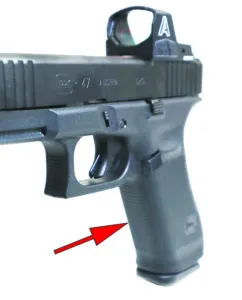
All the Gen5 features are built into the G47 — front slide serrations, better trigger, flared magazine well, enlarged floor plate, GMB barrel, and ambidextrous slide-stop levers. We ran the pistol with the small integrated backstrap, with no additional back strap module added. In hand, there is not a lot of newness with the G47. It felt familiar in a good way.
We liked the flat front grip strap, and the Gen5 trigger was noticeably better than older-generation triggers. There is the familiar mushy take-up followed by a more defined wall, and then the break at 7.6 pounds. Reset was long compared to the other guns. It is a better trigger overall, but it is still a Glock trigger.
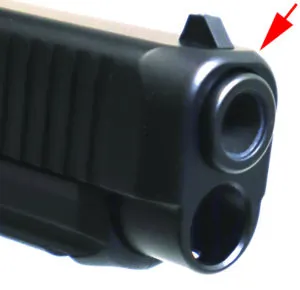
For our testing, we put an Ameriglo Haven Handgun Red Dot Sight Carry-Ready Combo on the Glock. This combo kit includes a red-dot optic and tall metal sights that co-witness with the optic. If we owned this pistol, we would mount the iron sights. For the test, it was run with just the red dot. The battery compartment is accessible on the side of the unit so the optic stays on the pistol when the battery gives up the ghost. It has a 12-hour run time and motion-activation mode to conserve battery life, which Ameriglo says gives two years of battery life at the medium brightness setting. There are two buttons on the left side that turn the red dot on and are used to adjust 11 brightness settings. Hold both buttons to turn it on and turn it off. The dot brightness is easy to adjust and showed a slight bit of flaring. Zeroing the dot was simple. Use the rim of a fired case to adjust elevation and windage. Directions — up/down, right/left — are clearly marked. The brightness adjustments were helpful because we noticed differences picking up the dot in bright light and in shade. The sight automatically turns on when it senses motion, which in our option is ideal for an EDC red dot.
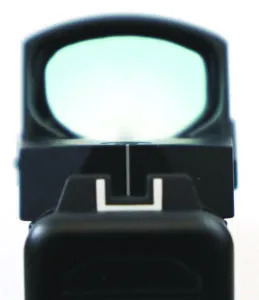
Going hot in the Failure Drill, the Glock was snappy in recoil, depending on the ammo being used. The undercut trigger guard and flat front grip strap allows for better control when shooting fast. There are some gaps between your palm and the grip when grasping the pistol. Some shooters familiar with Glock found it hard to miss the A zone areas of the target. Forward serrations are helpful to do a press check. Not sure why it took Glock all these years to add front slide serrations, but we are glad they finally did. The slide release is small and out of the way, so it won’t accidentally be pressed when the shooter grips the pistol during recoil. The rectangular magazine-release button is larger than previous-generation Glocks and is serrated. Ejecting an empty magazine is fast. Reloads proved to be smooth and fast. The magazine button can also be swapped for a left-handed shooter.
There were no issues at all with the Glock, and that is the expectation with any Glock pistol. Accuracy was good enough, but the Glock was the least accurate gun in the test. The smallest group with defense ammo was with Winchester Active Duty that measured 1.49 inches. With defense ammo, the smallest group measured was 2.04 inches with SIG V-Crown ammo. On average, across all ammos, the Glock is a solid 2-inch-group shooter at 25 yards, which is very good for a defense pistol.
Our Team Said: There is not that much different with the G47 MOS compared to a G17 Gen5, except for the compatibility with the G45 and G19. The gun performed flawlessly and provides simplicity in use. You basically point and shoot. The Ameriglo Haven red dot offers added value with the included iron sights. We like the way the battery is replaced. The cost of the red dot is reasonable, and it passed our in-house torture test. If you are a Glock fan, choose the G47 MOS if you want the latest full-size 9mm. It is reliable above all else, and that provides peace of mind in our book.
9mm Luger Range Data
To collect accuracy data, we fired five-shot groups from a bench using a rest. Distance: 25 yards with the reflex red dot sights. We recorded velocities using a ProChrono digital chronograph set 15 feet from the muzzles.| Federal American Eagle 115-grain FMJ | Beretta 92X | Glock G47 MOS | Springfield Armory Prodigy 4.25 | Walther PDP 4.5 |
| Average Velocity | 1135 fps | 1136 fps | 1140 fps | 1150 fps |
| Muzzle Energy | 329 ft.-lbs. | 330 ft.-lbs. | 332 ft.-lbs. | 338 ft.-lbs. |
| Smallest Group | 1.48 in. | 1.68 in. | 0.70 in. | 1.76 in. |
| Average Group | 1.59 in. | 1.88 in. | 1.02 in. | 1.98 in. |
| Winchester Active Duty 115-grain Ball | Beretta 92X | Glock G47 MOS | Springfield Armory Prodigy 4.25 | Walther PDP 4.5 |
| Average Velocity | 1220 fps | 1257 fps | 1229 fps | 1289 fps |
| Muzzle Energy | 380 ft.-lbs. | 404 ft.-lbs. | 386 ft.-lbs. | 424 ft.-lbs. |
| Smallest Group | 1.40 in. | 1.49 in. | 1.02 in. | 1.39 in. |
| Average Group | 1.44 in. | 1.54 in. | 1.06 in. | 1.45 in. |
| SIG V-Crown 124-grain JHP | Beretta 92X | Glock G47 MOS | Springfield Armory Prodigy 4.25 | Walther PDP 4.5 |
| Average Velocity | 1023 fps | 1051 fps | 1031 fps | 1116 fps |
| Muzzle Energy | 288 ft.-lbs. | 304 ft.-lbs. | 293 ft.-lbs. | 343 ft.-lbs. |
| Smallest Group | 2.10 in. | 2.04 in. | 0.97 in. | 1.56 in. |
| Average Group | 2.30 in. | 2.72 in. | 1.20 in. | 1.78 in. |
| Remington HTP 147-grain JHP | Beretta 92X | Glock G47 MOS | Springfield Armory Prodigy 4.25 | Walther PDP 4.5 |
| Average Velocity | 921 fps | 920 fps | 925 fps | 976 fps |
| Muzzle Energy | 277 ft.-lbs. | 276 ft.-lbs. | 279 ft.-lbs. | 311 ft.-lbs. |
| Smallest Group | 1.94 in. | 2.09 in. | 1.10 in. | 1.12 in. |
| Average Group | 1.97 in. | 2.38 in. | 1.27 in. | 1.26 in. |





